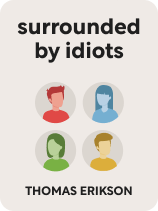

This article is an excerpt from the Shortform book guide to "Surrounded by Idiots" by Thomas Erikson. Shortform has the world's best summaries and analyses of books you should be reading.
Like this article? Sign up for a free trial here .
What does a Yellow personality look like? What are the strengths of the Yellow personality?
In the book Surrounded by Idiots, Yellow personality types are described as charismatic, popular, and optimistic. You would seek out a Yellow personality at work if you need help finding a creative solution to a problem.
Here’s everything you need to know about the Yellow personality type.
An Overview of the Yellow Personality Type
In Surrounded by Idiots, Yellow types have a charismatic personality and a bright outlook. Author Thomas Erikson says they see life as a smorgasbord of delights and are the first to try something new. Their driving forces in life are joy and laughter. Erikson writes that Hippocrates refers to this type as “sanguine,” which means “optimist.”
Yellow Personalities Are Social Butterflies
Yellow personalities are highly entertaining and tend to be popular. Have you ever been at a party and noticed a circle of laughing guests around one particular person? Erikson says this person is most likely a Yellow type. He adds that they’re avid storytellers, love the spotlight, and ignore no one. This positivity is contagious—when you spend time with a Yellow personality, Erikson says you tend to feel more cheerful yourself.
Red and Yellow personality types are both extroverts, but Erikson makes the distinction that Yellow personalities are highly focused on crafting relationships and personal connections, and Red types aren’t. He says people with a Yellow personality can talk to anyone (even strangers) and enjoy the conversation. They don’t care if the conversation leads to anything or is of particular substance—they simply enjoy human connection.
Like Red types, Yellow personalities like to keep a busy schedule, Erikson explains. Because they see the beauty in everything, they’re the most curious of the personality types. He says you can suggest almost any activity to a Yellow personality, and she’ll be excited to join you.
| Are Social Butterflies Always Extroverts? Introverts are often portrayed as shy homebodies who avoid social settings, but according to neuroscientists, this is a huge misconception. Rather, extroverts and introverts have different brain chemistry, one aspect of which is dopamine threshold. Dopamine is the hormone that makes us feel good, and the lower your threshold, the easier it is to become overstimulated and exhausted. Introverts can attend a party and be just as social as the extroverts, and they may even enjoy it just as much—they simply need more recovery time afterward. Consider this analogy: Two runners run the same race with similar results. One runner takes a day off and trains again the following day, while the other needs a week to recover. Parties and social gatherings are the same way for extroverts and introverts. |
Yellow Personalities Feel Positive About the Future
Like Red types, Erikson says Yellow personalities are able to make quick decisions. The difference between the two is that Reds will decide based on logic, while Yellow personalities follow their gut instinct, or what “feels right.”
People with this personality type are optimists, but they’re not in denial about the hardships of life. If something sad happens to them, Erikson says they’ll cry and feel sad, but they won’t dwell on it. Yellow personalities embrace their feelings in the moment but move on quickly.
Yellow types are highly creative and also resourceful. Erikson explains that they see solutions where others see problems, and their thinking is often out of the box. He says Yellow personalities are the most likely to exclaim, “I have an idea!”
| Optimism Changes With Age In 2020, the Journal of Research in Personality published the results of a study in which researchers posed a question: Do people’s life experiences affect their level of optimism? In other words, could a person who is normally optimistic become a pessimist after experiencing hardship? About 75,000 American, German, and Dutch people (ranging in age from 16 to 101) participated in the study. Researchers found that optimism fluctuated very little as a response to life circumstances, but it did change with age. Participants were shown to be the most optimistic in early adulthood and least optimistic in old age, with a plateau in middle age. |
Yellow Personalities Are Persuasive
People with Yellow-dominant personalities are skilled persuaders. Erikson says Yellow types can convince a room full of people to believe in a project through a bubbly and inspirational speech. He adds that they’re masters of language (both verbal and physical) and can convince you to think like them through their charismatic way of speaking. Politicians are often Yellow—including Bill Clinton.
(Shortform note: Regardless of personality, one way to become more persuasive in your speech is to eliminate qualifiers such as “I believe” or “I think.” Rather, state your belief as a fact. “This is the best option,” is more persuasive than, “I think this is the best option.” This works because people tend to follow the most confident person in the room.)
Seek a Yellow-Dominant Person If…
If you need help brainstorming new ideas or finding a creative solution to a tricky problem, Erikson says to find a Yellow personality type. For example, if you have two deadlines approaching simultaneously at work, your Yellow-dominant colleague will probably have an idea for how you can kill both birds with one stone.
(Shortform note: In the Myers-Briggs model, ENTPs are the most creative problem-solvers. They are skilled at seeing a challenge, dreaming up a conceptual solution, and then strategizing a practical solution.)
Erikson lists several famous Yellow personalities, including Robin Williams, Oprah Winfrey, and Ellen DeGeneres.
Negative Perceptions of Yellow Personality Types
In the DISC model, Erikson’s “Yellow” aligns with the “Inspiring” personality, which is typically pleasant in small doses but can be too intense for some. Erikson says others may view this personality type as overly talkative, scatterbrained, and childish.
The Perception: Yellow Personalities Talk Too Much
Yellow-dominant people live for conversation, and they’re the most gifted speakers of all the personality types. Erikson says there is rarely a filter between what a Yellow type thinks and what they say, so their speech is often a never-ending stream of consciousness. Because of this, Yellow personalities tend to dominate every conversation, and other personality types struggle to get a word in edgewise. Erikson says the other color-types (especially the introverted Blue personalities) quickly grow tired of listening to the nonstop talking.
(Shortform note: If you worry that you dominate conversations, try using the traffic light rule: In the first 30 seconds of speaking, you have a green light (your listener’s attention). In the following 30 seconds, you have a yellow light (you may or may not have your listener’s attention). After one minute of speaking, imagine you have hit a red light—stop and give your listener a chance to speak. If she wants you to continue, she will ask probing questions. If she doesn’t, then you have stopped at just the right time.)
The Perception: Yellow Personalities Are Scatterbrained
Erikson reiterates that Yellow types are more interested in ideas than in execution, and they can’t be bothered with details. As a result, Yellow-dominant people start a lot of projects that they don’t finish. He adds that they hate to follow convention and tend to have their own organizational systems that others can’t understand. For example, while you might look at a messy room and think it’s disorganized, a Yellow personality type can tell you (without looking) that her notebook is under the purple pillow next to the pile of laundry. Erikson explains that Yellow-dominant people are often late and they frequently forget deadlines and appointments—often because they try to store everything in their heads instead of using a calendar. For all of these reasons, others perceive them to be scatterbrained.
(Shortform note: Society tends to look down upon disorganization and messiness, but recent studies draw connections between clutter and creativity. In one experiment, participants were divided into two groups and asked to come up with new uses for a ping pong ball. The first group was given a clean and organized space to work in. The other group was placed in a messy room. The group in the messy room came up with more innovative ideas for the ping pong ball than did the group in the clean room, leading researchers to believe that disorganized environments are beneficial to the creative process.)
The Perception: Yellow Personalities Are Childish
Erikson says that Yellow-dominant people exhibit many behaviors that are common among children: They prefer speaking over listening, they need conversations and activities to be fun or they lose interest, and they push boundaries until redirected. Yellow types are often the most entertaining and engaging people in the room, but when it’s time to focus or be serious, their antics can be perceived as annoying and childish.
(Shortform note: Where is the line between harmless childlike behavior and true emotional immaturity? Psychologists say that emotional immaturity exists when a person hasn’t yet developed the ability to deal with adult emotions. A good test of this is how someone responds to confrontation. Do they listen to understand and look for a solution, or do they blame others, deny involvement, and lash out emotionally?)

———End of Preview———
Like what you just read? Read the rest of the world's best book summary and analysis of Thomas Erikson's "Surrounded by Idiots" at Shortform .
Here's what you'll find in our full Surrounded by Idiots summary :
- A detailed look at Thomas Erikson's four personality types
- How to navigate conflicts with coworkers
- How to effectively communicate and collaborate with bosses, employees, and colleagues






